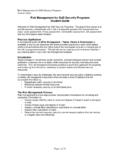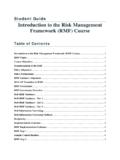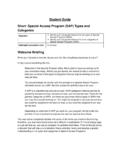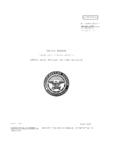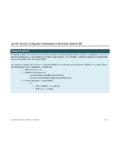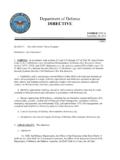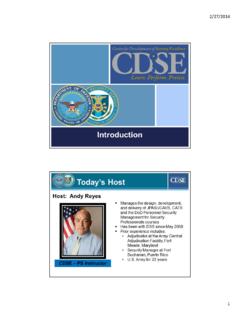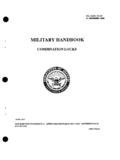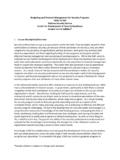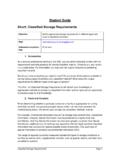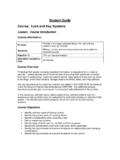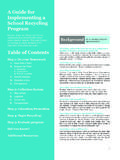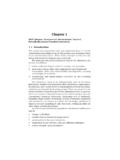Transcription of Storage Containers and Facilities Student Guide - …
1 Student Guide Course: Storage Containers and Facilities Lesson: Course Introduction Course Information Purpose Provide a thorough understanding of the Storage Containers and Facilities used by the DoD Audience Military, civilian, and contractor personnel responsible for physical security Pass/Fail % 75% on final examination Estimated completion time 80 minutes Course Overview Protecting DoD assets, such as classified material, arms, ammunition, and explosives (AA&E) and nuclear weapons, is imperative for our national security. Storage Containers and Facilities are an important part of ensuring DoD assets are protected from loss or compromise. In this course, you will learn about various types of Storage Containers and Facilities and their purposes as well as which ones are authorized for protecting sensitive or classified DoD assets.
2 You will also learn which ones require additional security measures to properly safeguard DoD assets. Course Objectives Identify the types of GSA-approved security Containers and their uses Identify the labeling requirements for GSA-approved security Containers Identify types of restricted areas and their uses Identify the physical security requirements for secure rooms, vaults, and Sensitive Compartmented Information Facilities (SCIFs) Identify Storage requirements for arms, ammunition, and explosives (AA&E) and nuclear weapons Identify best practices and requirements for use of security Containers and Facilities Storage Containers and Facilities Student Guide Course Introduction Page 2 Course Structure Course Introduction Storage Basics Storage Containers Restricted Areas Course Conclusion Storage Containers and Facilities Student Guide Course Introduction Page 2 Course Structure Course Introduction Storage Basics Storage Containers Restricted Areas Course Conclusion Student Guide Course: Storage Containers and Facilities Lesson.
3 Storage Basics Lesson Introduction Before you learn details about the various types of Storage Containers and Facilities used by the Department of Defense (DoD), there are some general concepts related to Storage Containers and Facilities you should know. This lesson will familiarize you with these concepts. The lesson objectives are: Identify the purpose of Storage Containers and Facilities used by the DoD Identify factors in determining which Storage method and supplemental protection to use Overview 1. Purpose Storage Containers and Facilities protect valuables, records, and sensitive and classified information and material, as well as conventional and nuclear weapons by delaying unauthorized entry.
4 Storage Containers and Facilities are important to our national security. As a security professional, you must prevent our sensitive assets from getting into the wrong hands and being used against us. Storage of our sensitive assets, such as AA&E and nuclear weapons, is also important to the safety of the general public because of the dangerous nature inherent to these assets. 2. Types of Storage While their purpose is the same, Storage Containers and Facilities come in different configurations and are designed to protect different types of DoD assets. Storage Containers are generally designed to protect smaller quantities of classified material and smaller sensitive items such as small weapons.
5 Storage Containers include security Containers such as cabinets and field safes as well as secure rooms and vaults. Storage Facilities , on the other hand, are restricted areas generally on military installations and are designed to protect certain types of classified material or items that require larger spaces such as nuclear weapons. Examples of Storage Facilities include SCIFs, which protect Sensitive Compartmented Information (SCI); AA&E Storage Facilities , which protect arms, ammunition, and explosives; and nuclear Storage Facilities , which protect nuclear weapons. Storage Containers and Facilities Student Guide Storage Basics Page 2 3. Types of Protection Security Containers and Facilities offer varying degrees of protection against different types of unauthorized entry.
6 The different types of unauthorized entry include forced entry, covert entry, and surreptitious entry. You will learn throughout this course that security Containers and doors to restricted areas and vaults are categorized by how well they delay these types of unauthorized entry. Let s take a look at security Containers , as an example, to see how each of these types of entry occurs. Forced entry occurs when someone breaks into the container or facility by using a tool, torch, or explosives, for example. Forced entry can cause obviously visible damage to the container , or it can cause less obvious damage, such as holes drilled behind cabinet labels. Covert entry occurs when someone breaks into a container by manipulating a lock by using an auto dialer machine to learn the combination of a combination lock or by picking a keyed lock, for example.
7 Covert entry is not as easily detected as forced entry, but trained persons can detect covert entry. An example of surreptitious entry is breaking into a container using radiological means such as an x-ray machine to view the dial rings on the older mechanical locks. With surreptitious entry, even trained persons have a difficult time detecting unauthorized entry. 4. Supplemental Protection Storage Containers or Facilities may not always provide enough protection for certain types of information or material on their own. Therefore, additional security measures or supplemental protection, such as intrusion detection systems, or alarms, and guards may be required at times. As you learn about the various types of Storage Containers and Facilities , you will learn which ones may require these additional security measures or supplemental protection as well as when these may be required.
8 5. Selection Factors When selecting a container or facility, there are a variety of factors to weigh. Here are some high level considerations for determining what Storage container or facility to use. One general principle holds true: the more sensitive the material being stored, or the greater the threat to it, the stricter your Storage and protection methods must be. For example, a Confidential document would require stricter Storage requirements than an unclassified document. Similarly, nuclear weapons would require stricter Storage requirements than Confidential classified material. You must also consider the type of material being stored. Paper material would have different Storage requirements than weapons, for example.
9 Finally, you must consider geographic location of the materials being stored. There are different requirements for materials being stored overseas, in war zones, for example, than for materials being stored in the United States. Storage Containers and Facilities Student Guide Storage Basics Page 3 Review Activity Try answering the following questions. When you are finished, see the Answer Key at the end of this Student Guide to check your answers. Question 1 Which of the following statements are true of Storage Containers and Facilities ? Select all that apply. Storage Containers and Facilities protect valuable and/or sensitive assets by delaying unauthorized entry. They are categorized by how well they delay different types of unauthorized entry.
10 They are important to our national security and to the safety of the general public. They are required only for the Storage of classified information. Question 2 Which of the following would be factors you would need to consider when selecting Storage Containers and Facilities ? Select all that apply. Whether the TOP SECRET material being stored is a set of documents or a weapon system If the material is being stored in a war zone or not Whether a document is CONFIDENTIAL or TOP SECRET Whether the items being stored are conventional AA&E or nuclear weapons Lesson Conclusion In this lesson, you learned about the purpose and types of Storage Containers and Facilities , the types of protection they provide, that supplemental protection is required at times, and what factors must be considered when selecting Storage Containers and Facilities .
